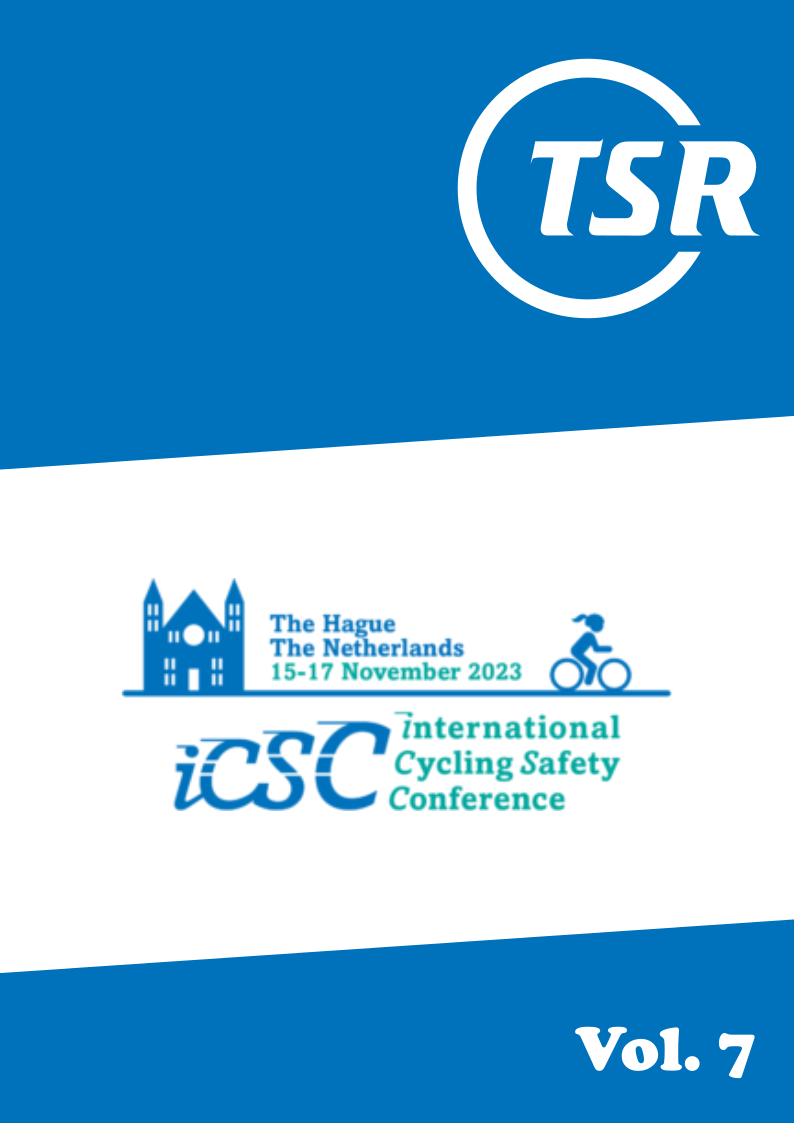Keep me safe—evaluation of safety perception of different bicycle facilities
DOI:
https://doi.org/10.55329/vrrz2104Keywords:
bicycle lane, expected safety, perceived safety, traffic safetyAbstract
Bicycle traffic constitutes a central aspect of present and future inner-city traffic. Therefore, cyclists' safety is increasingly the focus of research. A current discussion is whether a structural separation between bicycle and motorized traffic using light segregation improves road safety and the perceived safety of cyclists compared to a design using markings or other forms of light segregation. The field study was conducted on a street in Zurich that is a source of conflict for cyclists with motorized traffic by implementing four different forms of light segregation and examining their influence on the safety assessment. The (1) colored bicycle lane was supplemented by (2) a continuous line, (3) light segregation that still allows cyclists or cars to ride over them (discs), and (4) light segregation with guide beacons that do not allow cyclists nor cars to ride over them. A video-based traffic analysis was conducted for each stage to assess the conflicts between cyclists and motorized traffic. Regarding safety perception, cyclists were asked before and after each conversion about their general safety assessment and perception of the specific street section. Moreover, the conversions were presented to participants via pictures before they were implemented in order to assess if a safety assessment based on pictures is comparable to a perceived safety perception in reality. Objectively, fewer adaptive actions were recorded for all three conversions compared to the initial design. Significant differences were found between the conversions regarding perceived safety, with the light segregation using discs being rated as the safest. The safety assessment based on pictures, however, revealed no significant differences. These results are a basis for further research on safety assessments and the relationship between objective and subjective safety for cyclists.
Downloads
References
Aldred, R., J. Dales (2017), 'Diversifying and normalising cycling in London, UK: An exploratory study on the influence of infrastructure', Journal of Transport & Health, 4, 348–362. DOI: https://doi.org/10.1016/j.jth.2016.11.002
Autelitano, F., F. Giuliani (2021), 'Colored bicycle lanes and intersection treatments: International overview and best practices', Journal of Traffic and Transportation Engineering (English Edition), 8(3), 399–420. DOI: https://doi.org/10.1016/j.jtte.2021.03.003
Beitel, D., J. Stipancic, K. Manaugh, L. Miranda-Moreno (2018), 'Assessing safety of shared space using cyclist-pedestrian interactions and automated video conflict analysis', Transportation Research Part D: Transport and Environment, 65, 710–724. DOI: https://doi.org/10.1016/j.trd.2018.10.001
Chataway, E. S., S. Kaplan, T. A. S. Nielsen, C. G. Prato (2014), 'Safety perceptions and reported behavior related to cycling in mixed traffic: A comparison between Brisbane and Copenhagen', Transportation Research Part F: Traffic Psychology and Behaviour, 23, 32–43. DOI: https://doi.org/10.1016/j.trf.2013.12.021
Chaurand, N., P. Delhomme (2013), 'Cyclists and drivers in road interactions: A comparison of perceived crash risk', Accident Analysis & Prevention, 50, 1176–1184. DOI: https://doi.org/10.1016/j.aap.2012.09.005
Chen, L., C. Chen, R. Srinivasan, C. E. McKnight, R. Ewing, M. Roe (2012), 'Evaluating the safety effects of bicycle lanes in New York City', American Journal of Public Health, 102, 1120–1127. DOI: https://doi.org/10.2105/AJPH.2011.300319
Elvik, R., T. Bjørnskau (2005), 'How accurately does the public perceive differences in transport risks?: An exploratory analysis of scales representing perceived risk', Accident Analysis & Prevention, 37(6), 1005–1011. DOI: https://doi.org/10.1016/j.aap.2005.05.003
Félix, R., P. Cambra, F. Moura (2020), 'Build it and give ‘em bikes, and they will come: The effects of cycling infrastructure and bike-sharing system in Lisbon', Case Studies on Transport Policy, 8(2), 672–682. DOI: https://doi.org/10.1016/j.cstp.2020.03.002
Foster, N., C. M. Monsere, J. Dill, K. Clifton (2015), 'Level-of-service model for protected bike lanes', Transportation Research Record, 2520(1), 90–99. DOI: https://doi.org/10.3141/2520-11
Fyhri, A., K. Karlsen, H. B. Sundfør (2021), 'Paint it red-a multimethod study of the nudging effect of coloured cycle lanes', Frontiers in Psychology, 12, 662679. DOI: https://doi.org/10.3389/fpsyg.2021.662679
Ghielmetti, M., R. Steiner, J. Leitner, M. Hackenfort, S. Diener, H. Topp (2017), 'Flächiges Queren in Ortszentren—langfristige Wirkung und Zweckmässigkeit [Wide-area crossings in town centres—long-term impact and practicality]', Bundesamt für Strassen, Forschungsprojekt SVI 2011/023.
Götschi, T., J. Garrard, B. Giles-Corti (2016), 'Cycling as a part of daily life: A review of health perspectives', Transport Reviews, 36(1), 45–71. DOI: https://doi.org/10.1080/01441647.2015.1057877
Hackenfort, M. (2012), 'Psychologische Sicherheitsforschung: Ursachen und Folgen von subjektiven Fehleinschätzungen und ihre Bedeutung für den Strassenverkehr [Psychological safety research. Causes and consequences of subjective misjudgements and their significance for road traffic]', SIAK-Journal—Zeitschrift für Polizeiwissenschaft und polizeiliche Praxis, (3) 16–26.
Hamilton, T. L., C. J. Wichman (2018), 'Bicycle infrastructure and traffic congestion: Evidence from DC's Capital Bikeshare', Journal of Environmental Economics and Management, 87, 72–93. DOI: https://doi.org/10.1016/j.jeem.2017.03.007
Heesch, K. C., S. Sahlqvist, J. Garrard (2011), 'Cyclists' experiences of harassment from motorists: Findings from a survey of cyclists in Queensland, Australia', Preventive Medicine, 53(6), 417–420. DOI: https://doi.org/10.1016/j.ypmed.2011.09.015
Henson, R., A. Skinner, N. Georgeson (1997), 'Analyse des freins à l'utilisation de la bicyclette à Manchester [Analysis of cycling deterrence factors in Greater Manchester]', Velo City'97: redescubrir la bicicleta-estrategias para una nueva movilidad, Barcelona, Spain, 15–19 September 1997.
Hertach, P., Y. A. Stu¨rmer, R. Allenbach, K. Huwiler, S. Niemann, A. Uhr (2022), 'Sinus 2022: Sicherheitsniveau und Unfallgeschehen im Strassenverkehr 2021 [Sinus 2022: Safety level and accident rates in road traffic 2021]', Beratungsstelle für Unfallverhütung.
Kaplan, S., C. G. Prato (2016), ' “Them or Us”: Perceptions, cognitions, emotions, and overt behavior associated with cyclists and motorists sharing the road', International Journal of Sustainable Transportation, 10(3), 193–200. DOI: https://doi.org/10.1080/15568318.2014.885621
Klebelsberg, D. V. (1982), Verkehrspsychologie, (Heidelberg, Germany: Springer Berlin). DOI: https://doi.org/10.1007/978-3-642-47507-8
Koorey, G., A. Wilke, J. Aussendorf (2013), 'Assessment of the effectiveness of narrow separators on cycle lanes', IPENZ Transportation Group 2013 Conference, Dunedin, New Zealand, 14–16 April 2013.
Kronprasert, N., C. Sutheerakul, T. Satiennam, P. Luathep (2021), 'Intersection safety assessment using video-based traffic conflict analysis: The case study of Thailand', Sustainability, 13(22), 12722. DOI: https://doi.org/10.3390/su132212722
Maizlish, N., J. Woodcock, S. Co, B. Ostro, A. Fanai, D. Fairley (2013), 'Health cobenefits and transportation-related reductions in greenhouse gas emissions in the San Francisco Bay area', American Journal of Public Health, 103, 703–709. DOI: https://doi.org/10.2105/AJPH.2012.300939
McNeil, N., C. M. Monsere, J. Dill (2015), 'Influence of bike lane buffer types on perceived comfort and safety of bicyclists and potential bicyclists', Transportation Research Record, 2520(1), 132–142. DOI: https://doi.org/10.3141/2520-15
Parkin, J., M. Wardman, M. Page (2007), 'Models of perceived cycling risk and route acceptability', Accident Analysis & Prevention, 39(2), 364–371. DOI: https://doi.org/10.1016/j.aap.2006.08.007
Park, J., M. Abdel-Aty, J. Lee, C. Lee (2015), 'Developing crash modification functions to assess safety effects of adding bike lanes for urban arterials with different roadway and socio-economic characteristics', Accident Analysis & Prevention, 74, 179–191. DOI: https://doi.org/10.1016/j.aap.2014.10.024
Petermann, I., G. Weller, B. Schlag (2008), 'Beitrag des visuellen Eindrucks zur Erklärung des Unfallgeschehens in Landstraßenkurven [Contribution of the visual impression to the explanation of accidents in country road curves]', in Schade, J., A. Engeln (eds.), Fortschritte der Verkehrspsychologie, (Wiesbaden, Germany: VS Verlag für Sozialwissenschaften). DOI: https://doi.org/10.1007/978-3-531-90949-3_6
Pulugurtha, S. S., V. Thakur (2015), 'Evaluating the effectiveness of on-street bicycle lane and assessing risk to bicyclists in Charlotte, North Carolina', Accident Analysis & Prevention, 76, 34–41. DOI: https://doi.org/10.1016/j.aap.2014.12.020
Reichel, D. (2012), 'Nationaler Radverkehrsplan 2020: Den Radverkehr gemeinsam weiterentwickeln [National cycling plan 2020: Developing cycling together]', Bundesministerium für Verkehr, Bau und Stadtentwicklung.
Rietveld, P., V. Daniel (2004), 'Determinants of bicycle use: Do municipal policies matter?', Transportation Research Part A: Policy and Practice, 38(7), 531–550. DOI: https://doi.org/10.1016/j.tra.2004.05.003
Rondinella, G., A. Fernandez-Heredia, A. Monzón (2012), 'Analysis of perceptions of utilitarian cycling by level of user experience', TRB Annual Meeting, Washington, D.C., USA, 22–26 January 2012.
Schepers, P., M. Hagenzieker, R. Methorst, B. van Wee, F. Wegman (2014), 'A conceptual framework for road safety and mobility applied to cycling safety', Accident Analysis & Prevention, 62, 331–340. DOI: https://doi.org/10.1016/j.aap.2013.03.032
Smith, P. C. (1976), 'Behaviors, results, and organizational effectiveness: The problem of criteria', in M D Dunnette, (ed.), Handbook of Industrial and Organizational Psychology, (Chicago, USA: Rand McNally).
Stadt Zürich, (2023), 'Velo in Zürich: Bericht zur Veloförderung und Velosicherheit [Cycling in Zurich: Report on bicycle promotion and bicycle safety.]', Stadt Zürich.
Steiner, R., J. Leitner, M. Hackenfort, G. Benedek, M. Doerfel, B. Lüthi (2023), 'Alternative Methoden zur Messung lokaler Verkehrssicherheit [Alternative methods for measuring local traffic safety]', Bundesamt für Strassen, Forschungsprojekt SVI 2018/002.
Tarko, A. P. (2018), 'Surrogate measures of safety', in Lord, D., S. Washington (eds.), Safe Mobility: Challenges, Methodology and Solutions, (Bingley, UK: Emerald Publishing Limited). DOI: https://doi.org/10.1108/S2044-994120180000011019
Transport for London, (2014), London Cycling Design Standards, (London, UK: Transport for London).
von Stülpnagel, R., N. Binnig (2022), 'How safe do you feel?-A large-scale survey concerning the subjective safety associated with different kinds of cycling lanes', Accident Analysis & Prevention, 167, 106577. DOI: https://doi.org/10.1016/j.aap.2022.106577
Winters, M., M. Branion-Calles (2017), 'Cycling safety: Quantifying the under reporting of cycling incidents in Vancouver, British Columbia', Journal of Transport & Health, 7(Part A), 48–53. DOI: https://doi.org/10.1016/j.jth.2017.02.010
Published
How to Cite
Issue
Section
Categories
License
Copyright (c) 2024 Tanja Stoll, Désirée Hagmann, Jakob Leitner, Markus Hackenfort

This work is licensed under a Creative Commons Attribution 4.0 International License.











